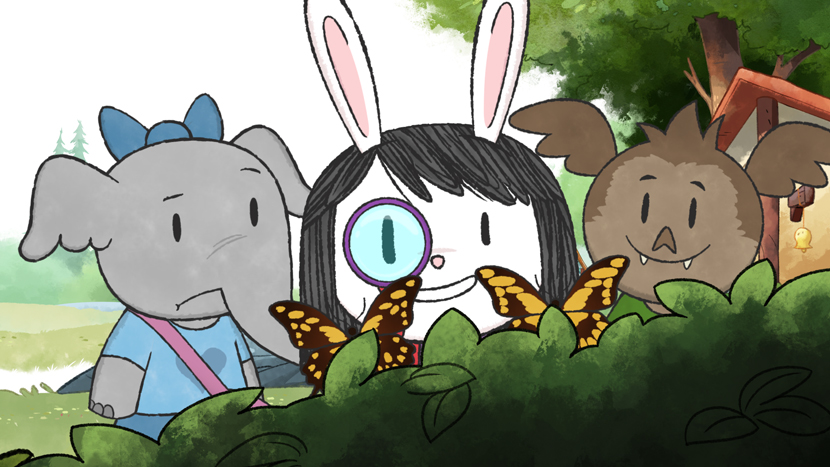Answering Preschoolers’ Favorite Question: “Why?”
By Stacey Lutkoski
A curious bunny in the new PBS Kids cartoon Elinor Wonders Why uses scientific observations to learn about the world around her.
October 20, 2020
Science Culture Communications Review
As anyone with a small child can tell you, the most-used word in a preschooler’s vocabulary is why. Why do squirrels eat all the birdseed from our birdfeeder? Why is it dark when I wake up in the winter, and light when I go to bed in the summer? Why does your breath smell like that? (Because I need coffee to keep my energy up to answer all these questions!)
The new animated PBS Kids show Elinor Wonders Why captures the curiosity of young children and channels their questions into scientific discovery. Elinor is a bunny who uses every opportunity to learn more about the world around her. Her catchphrase—“That is so interesting!”—is a different take on the preschooler’s refrain of “Why?” But what makes Elinor special is that she follows up with “We need more observations!” and demonstrates how to find answers on your own or by collaborating with your friends.

Courtesy of PBS KIDS
Some of the episodes tread well-covered ground, as when a game of hide-and-seek leads to a lesson about camouflage. The more interesting storylines take a more trial-and-error approach. One of my favorites is “Wind in the Web.” In it, Elinor and her good friends, Ari the bat and Olive the elephant, offer to help Mr. Raccoon put up a banner to advertise new treats at his bakery. They run into trouble when the wind blows the banner away. Elinor and her friends consider a number of ways to keep the banner in place, but none of them fixes the problem. Finally, she notices a spiderweb that is undisturbed by the wind (“That’s so interesting!”), and through observation she realizes that the wind is going through the web’s holes. Elinor, Ari, and Olive cut holes in the banner to allow the wind to pass through, and the banner stays put.
Elinor and her friends tackle problems without getting discouraged. The show’s creators—cartoonist and robotics engineer Jorge Cham (of the PhD Comics series) and physicist and educator Daniel Whiteson—weave the foundations of scientific inquiry into each episode without being heavy-handed.
Perhaps the most important lesson is that experiments don’t always work. Elinor, Ari, and Olive often approach a problem from several angles before finding a solution. That perseverance is the key to their progress. They also learn that happy accidents can lead to breakthroughs.
I sat down to watch a couple of episodes with my two kids. My first-grader happily watched one of the 11-minute segments, and then left to do something else. My three-year-old is in the show’s target preschool demographic, and he loved it. The pleasing animation has a hand-drawn style, and the characters are voiced by child actors, lending them authenticity. Many of the episodes include a short song, because music is the way to a preschoolers’ heart.
Like many people during the COVID-19 pandemic, I am struggling to balance the many aspects of my life that now take place at home. We all know about the benefits of limiting screen time for young children, but sometimes—when you’re in a meeting at the kitchen table with one kid in a Zoom class and another is hanging off your arm—a program such as Elinor Wonders Why can seem miraculous. It offers a brief, engaging, and effortlessly educational reprieve, and it may even give your children the confidence to look for answers to “Why?” on their own.
American Scientist Comments and Discussion
To discuss our articles or comment on them, please share them and tag American Scientist on social media platforms. Here are links to our profiles on Twitter, Facebook, and LinkedIn.
If we re-share your post, we will moderate comments/discussion following our comments policy.